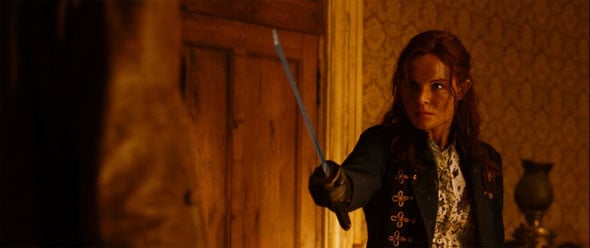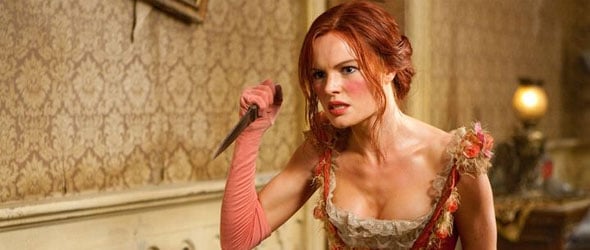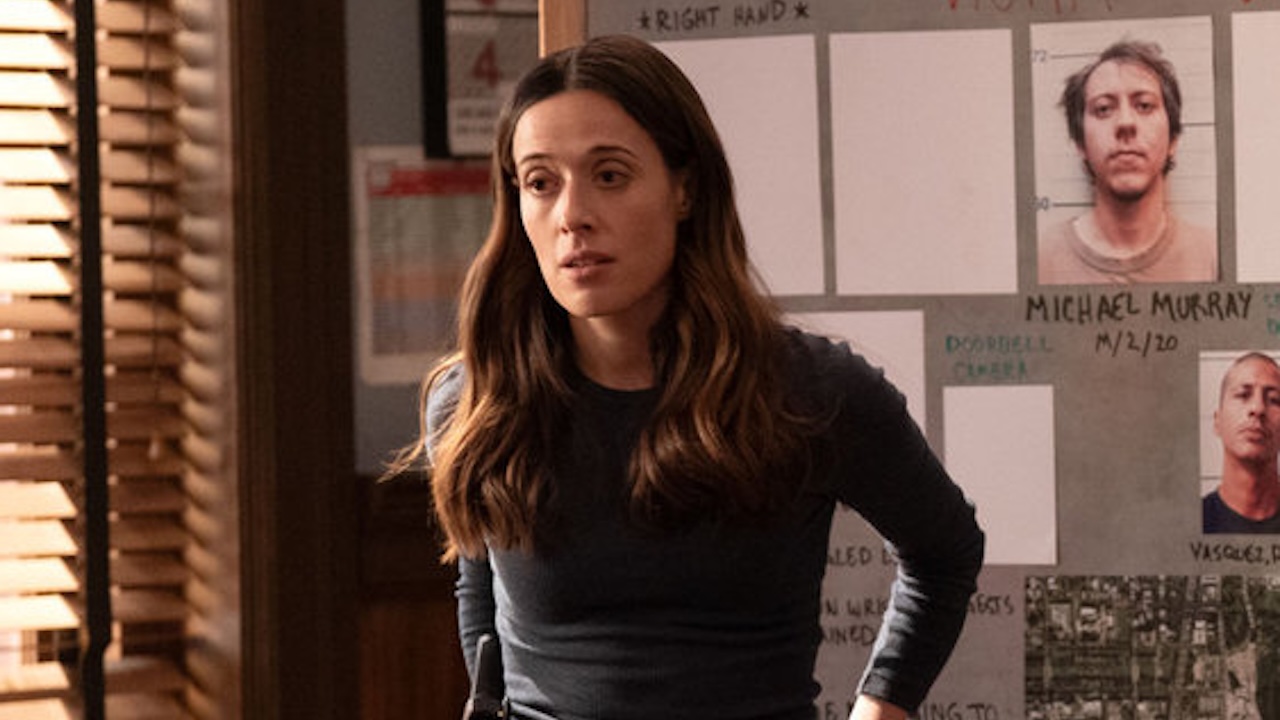Interview: The Warrior's Way's Kate Bosworth And Danny Huston

When a good actor is performing, it’s not just about saying the lines – they take in every element around them and use it to fuel their performance. Danny Huston and Kate Bosworth are both actors that would most certainly use this method, but it becomes quite difficult when the only thing around you is a bunch of green screen. But sometimes that’s just a challenge that comes with the job.
In The Warrior’s Way, an east-meets-west mash-up that sees Samurai enter the old west, Huston and Bosworth not only had to deal with the challenge of the green screen, but also performed their own stunts and worked with a first-time director whose first language is not English. Sitting down at a roundtable interview with the two actors, they opened up about how they over came the multitude of obstacles that came with making the film and what it was like working with Dong-gun Jang, who, in is largely known in Asia as the Korean Brad Pitt. Check my interview with Kate Bosworth and Danny Huston below.
What excited you about this project?
Kate Bosworth: Well, for me, it started with the screenplay; I saw the screenplay and I had never read anything like it. It was incredibly original and really a collision of different genres all mixed into one. I was just very attracted to the uniqueness of the project and the fact that the project is a real kaleidoscope of many different elements, but there’s a very strong through line of good versus evil and that love conquers all. So the kind of dichotomy, the complexity on one hand, and then the simplicity on the other; a real kind of beautiful poetry interwoven through the whole project was what was most attractive.
Danny Huston: I would agree with that. It’s a fable beautifully and explicitly told with these western touches – Sergio Leone, and all the interesting westerns that were made. Our lead is like a Clint Eastwood, and there’s this wonderful romantic threat to it. It’s very exciting as a read.
You both did a lot of your own stunt work on this film. What kind of preparation did you have to do physically?
KB: We just went into a room and started knocking each other to shit [laughs] – beating each other to a pulp.
Your Daily Blend of Entertainment News
DH: Well, I worked with a stunt girl and Kate worked with a stunt guy – we had a certain amount of time, not a lot, we probably could have had more, but that created a sort of anticipation and adrenaline. So when we actually went to shoot the scenes we were challenging each other for the first time. We knew more or less what the dance would be like, but there’s a lot of trust involved, especially when you have someone like me with a big mask on, not able to see out of one eye swinging a large sword at you. It’s a real dance and we pushed it as much as we could and we’re proud that it made it into the film – we didn’t have to cut away to stunt people. Maybe 95% of the stuff is there?
KB: Yeah. So much of those action sequences were essential to the characters development and whether it was myself and Dong-gun [Jang] and that romantic kind-of lead up, frantic, wild lead up to their kiss, I feel like it had to be him and I because it was so essential to their development. And then, similarly but on the completely other side of the coin, [the scene with Danny], for both of them, facing off, and fulfilling this obsessive attraction to each other.
DH: Obsession, yes.
KB: We wanted to do as much as possible for those reasons, I think.
DH: Yeah. And we’re not hanging off of wires or anything, we’re really doing it.

Was there a difference in the director’s approach, from a Korean perspective, that you wouldn’t have seen in a western filmmaker’s?
DH: Very specific and very clear about what he wanted in a concise… and at times there were misunderstandings. He was saying, “I want you to take the gun and shoot up at the sky.” And I said, “Right, but what am I shooting at?” And he said, “Light 26” – which is a large stage light with the number 26 on it. And I was like, “Yes, but what’s the light?” [laughs]. And he’s goes, “It’s a ninja!” “Oh! I see! Yes, of course. How many ninjas?” “Hundreds of ninjas. All around you, they’re ninjas!” “Oh, okay. I get it!” So especially with the green screen, not really knowing what it is that you’re looking at you really depend on the director to create that world for you.
KB: Also, the sort of nuance of emotion. For example, sometimes it would be difficult to understand, he would say to me, “I think she’s very angry in this scene.” And I’d say, “Oh, wow. That’s quite an intense notion.” And I’d play it and he’d say, “Not so angry.” And I’d say, “Frustrated?” And he’d say, “Yeah, yeah, yeah! Frustrated!” [laughs] So it was sort of like an umbrella of an emotion and finding the tentacles of exactly what it was that he was specifically looking for. And it was often a challenge, but when you got there at least it was “Oh, okay. We found it.” We felt successful finding that specificity together.
With all of the east meets west aspects of this film, was there anything on paper that you didn’t know how it would come together but then were surprised by?
DH: I felt it all worked on paper, but I was utterly surprised every time I saw it come together. I suppose particularly the carnies, particularly Fellini-esque, to grab another Italian, sort of magic characters and this sort of wandering circus atmosphere that the piece had. I was completely struck by it myself visually for the first time. And now that the film has finally come together I can see what was intended, which I didn’t really know how it was going to come out until all of the effects were done.
KB: The whole film was shot on this vast stage and various kind of bits of sets – literally it would be this entire room covered in neon green. In a way it was the things we were surviving with was the costumes.
DH: The clothing, absolutely.
KB: The costume really gave us some kind of visual aid as to where we were in terms of character development and physically what will be around us because it was literally a blank canvas. We would often say, “What’s happening over there?” [laughs]. And so it’s exciting to see it come together.
DH: And all my guys, my cowboy guys, full of grit and dirt and everything, when they came on stage it was astonishing – a stage packed with horses.

Did it bring you closer together as performers when all you have to rely on is each other?
DH: I think so, yes, very much. People have been asking us a lot of questions as far as what it’s like working with people of a different culture and different country, and in a way all actors are kind of gypsies or tinkerers or a traveling circus, in a way. So here we all were in New Zealand working on this extraordinary film so it was easy for us to feel a sort of kinship.
KB: Especially being, we were in New Zealand as well, which was so far away from everything we felt like we just… sometimes we would just look around at these crazy costumes and this empty stage and go like, “Well, we’re here together. We know we’re here together” [laughs]. Because you spiral into a little bit of a madness sometimes, I know I did.
DH: Oh yes. Oh yes.
Working with a first time writer and director, how much creative input did you have in the film?
DH: I think a certain amount of freedom for interpretation, but the character was very clearly linear. And as I say, he had a particular world that he was creating around us so in a sense there was little control that I felt I had in regards to what that world would be. So if I’m looking at a sunset, I have no idea what he’s actually going to give me. So my reactions and my way that I behave within the palate, a big contributor was something the effects were going to do later or that he was going to do later, and this world that I had to trust existed.
KB: The only sort of head-butt I had on the look of my character was the hair. I wanted her to be a redhead and I was hell-bent with her being a redhead. I thought how could you not have this fierce, fiery, crazy, feral woman in the middle of the desert with jet black hair – I love jet black hair, but she has to be a redhead! So I fought tooth and nail with that, but I won – I won that battle [laughs].
DH: Well, that works very well for the flashback when you’re younger, because it’s clear
KB: Very distinct. You would always talk about the sunsets and just the idea, I had this romantic kind of idea of her. I don’t know, I thought it really works. It really helped define her for me. I know that sounds strange, but sometimes the physicality… really, you can get hooked on something that’s important.
DH: Absolutely.

Did anyone get hurt or injured doing the stunts?
KB: [To Danny] You lost a finger, right? [laughs]
DH: It’s back. Yes. Usually when you’re working you don’t really feel what’s going on physically, but when you go back home and you’re like, “Oh my God!” [laughs] And you’ll kind of wear the wounds, or bruises I should say, with a certain amount of pride.
KB: When you’re working through the scene you’re just working on such adrenaline and then always later it’s “Oh God, my back hurts!” or “Oh wow, where did that come from?” It’s like your entire arm is bruised up. It’s just you don’t think about it when you’re working.
DH: We had a break, it was over Christmas, that broke up that whole sequence. Which kind of helped us.
KB: Yeah, because we were…
DH: And it was very hot. Very, very hot. It was New Zealand in the Christmas, which was summer. For some reason it was extraordinarily hot, it might have had something to do with the big rubber coat and the mask [laughs].
KB: Oh yeah, the mask, that was so horrible. And the heat…
DH: But it’s fun. You know, that kind of physical challenge.
Kate, how did you develop the chemistry between your character and Dong-gun?
KB: We liked each other so much when we first met that it was very easy to get along. The relationship was pretty well planned, pretty well structured on the page, and we rehearsed a lot because he wanted to get his English as perfect as possible. So we’d rehearse and rehearse and we got to know each other through rehearsals very well. It was easy to find that connection with each other and bring it to screen. It wasn’t a challenge at all.

How did you deal with and was there any hysteria involved in working with Dong-gun Jang, who is seen as the Korean Brad Pitt?
KB: I know! I feel like he loved so much being in New Zealand because he was anonymous for one of the first times in his life and he just couldn’t believe it. We really felt like we were on the edge of the world in New Zealand.
DH: Clinging to the edge of the world.
KB: Clinging, yeah. Clinging is a better word. We were clinging on the edge of the world.
DH: But he’s a very cool cat. He’s a very cool guy and working with him was just a joy. Mainly my character, The Colonel, was just terrified of him [laughs], so there was a lot of interaction, more than anything I would just run away as quickly as I can. But observing him work I couldn’t help but notice how cool and what a gentlemen he is. Very reserved.
KB: Very quiet. Very aware as well; sensitive of people.
Danny talked about his trials and tribulations with his wardrobe, but what was it like fighting in a dress, Kate?
KB: Well, we planned the final showdown between The Colonel and Lynne, we planned that wardrobe out as intelligently as possible. Because I was either in hide pants, and I thought “I don’t want to be in hide pants. How am I going to move in these? I can barely move in them.” And the dress was actually pretty easy to maneuver in, but we didn’t have too much… you caught me pretty quick.
DH: It was tight too.
KB: Yeah, it was tight. You’re right. I forgot about that. It was hard to breathe in that one, that was a bit of a challenge. So the ultimate challenge was in Dockers and a blouse, so it was a little easier to maneuver in.

Eric Eisenberg is the Assistant Managing Editor at CinemaBlend. After graduating Boston University and earning a bachelor’s degree in journalism, he took a part-time job as a staff writer for CinemaBlend, and after six months was offered the opportunity to move to Los Angeles and take on a newly created West Coast Editor position. Over a decade later, he's continuing to advance his interests and expertise. In addition to conducting filmmaker interviews and contributing to the news and feature content of the site, Eric also oversees the Movie Reviews section, writes the the weekend box office report (published Sundays), and is the site's resident Stephen King expert. He has two King-related columns.
